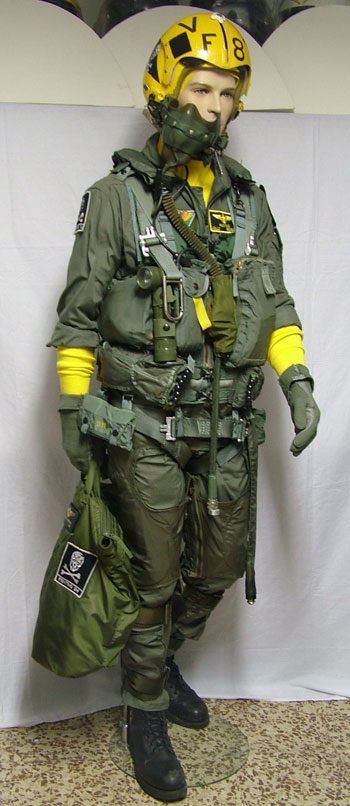
US Navy pilot flight equipment of VF-84 Jolly Rogers used during the 1979-1980.
|
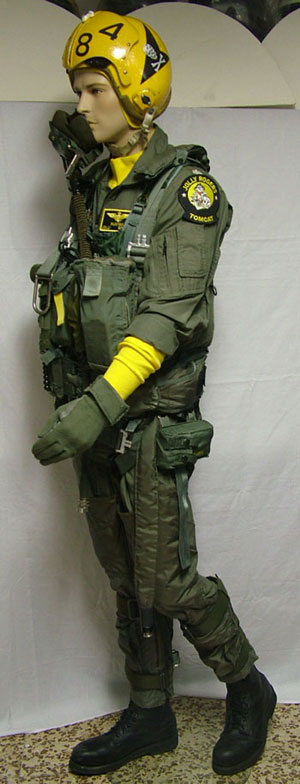
US Navy pilot flight equipment of VF-84 Jolly Rogers used during the 1979-1980. |
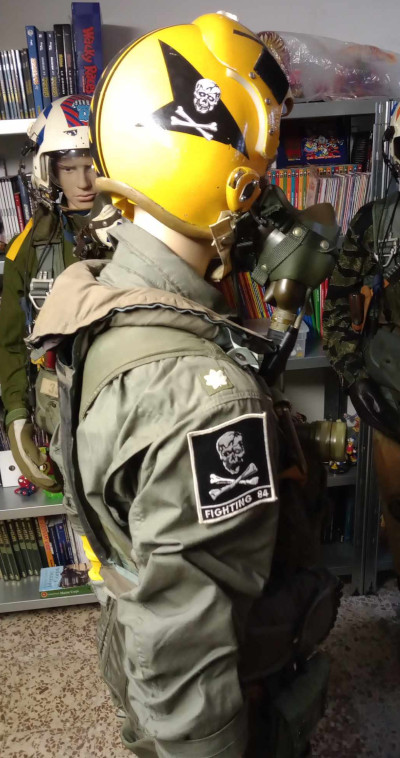
US Navy pilot flight equipment of VF-84 Jolly Rogers used during the 1979-1980.
|
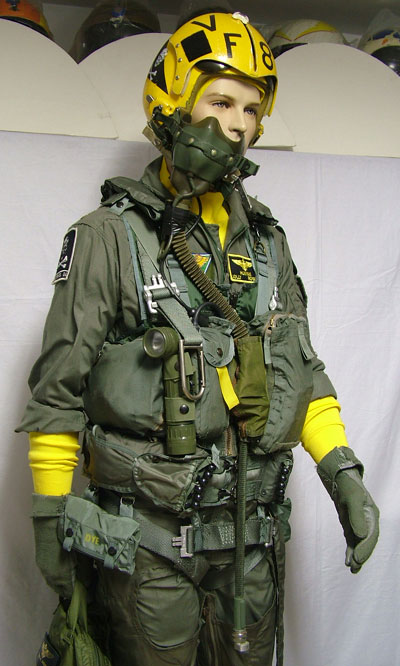
US Navy pilot flight equipment of VF-84 Jolly Rogers used during the 1979-1980. |
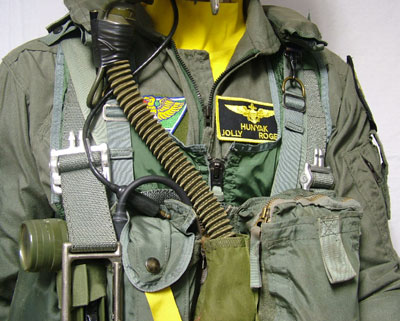
This US Navy pilot flight equipment setup is a tribute in memory of Capt. Edward "Hunyak" K. Andrews (1942-2014)
|
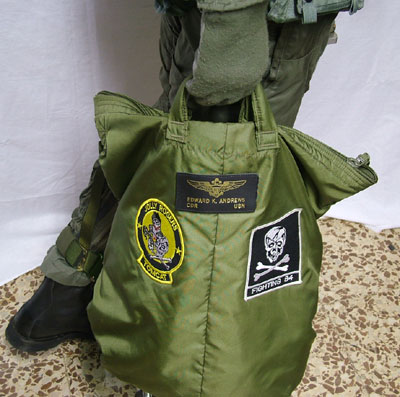
Edward "Hunyak" K. Andrews with the rank of Cdr. has been XO of VF-84 Jolly Rogers in 1979-1980 and CO of the same squadron in 1981-1982 with two operative cruises on board of USS Nimitz. |
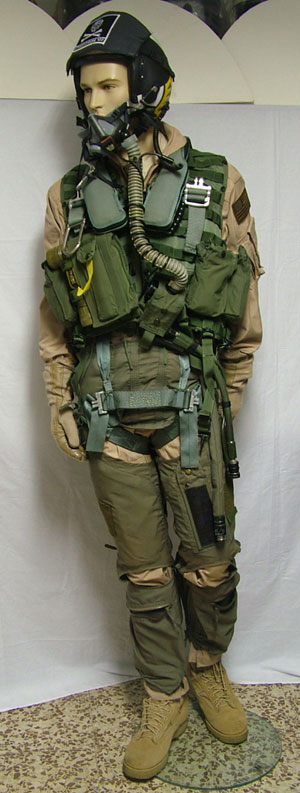
US Navy pilot flight equipment of VFA-103 Jolly Rogers used during the 2010.
|
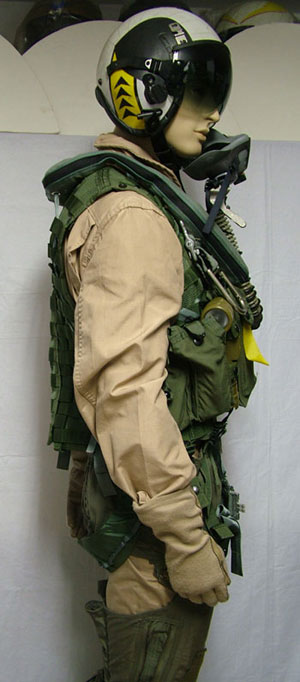
US Navy pilot flight equipment of VFA-103 Jolly Rogers used during the 2010. |
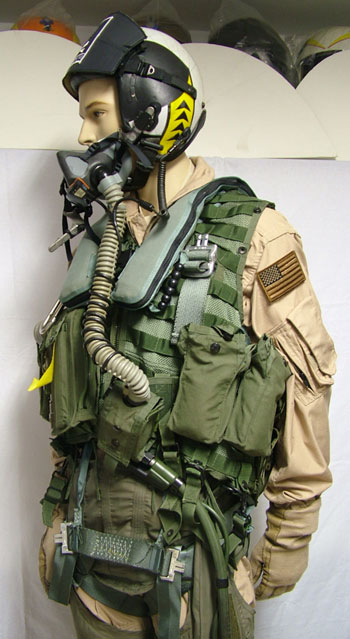
US Navy pilot flight equipment of VFA-103 Jolly Rogers used during the 2010.
|
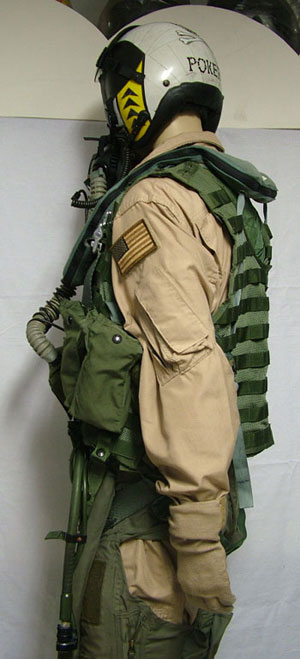
US Navy pilot flight equipment of VFA-103 Jolly Rogers used during the 2010. |
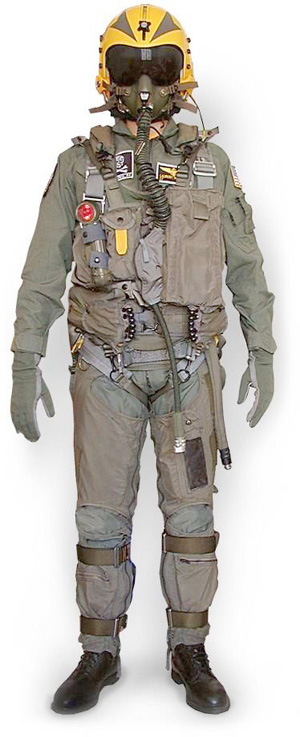
US Navy pilot flight equipment used during the 80s.
(Chamelon Flightgear on the web) |
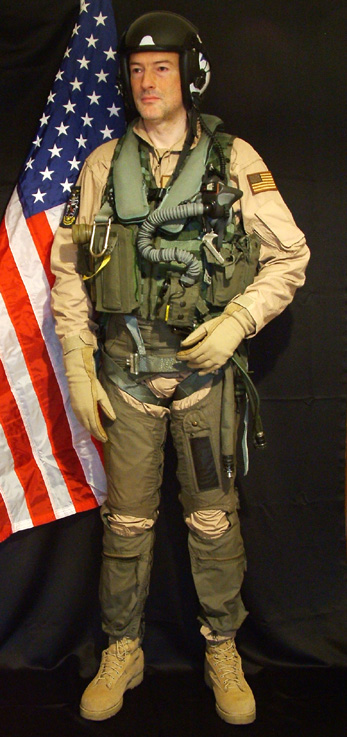
US Navy pilot equipment used during the 2000 |
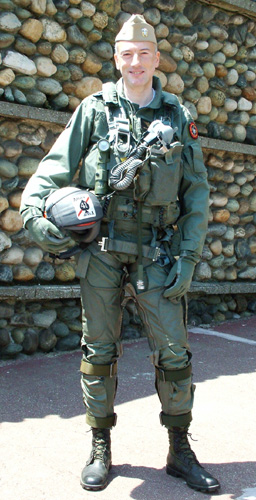
US Navy pilot equipment used during the early 90s |
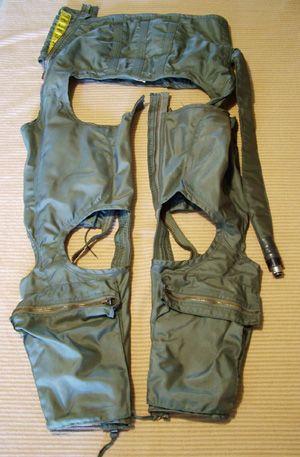
US Navy anti-g garment CSU-15/P |
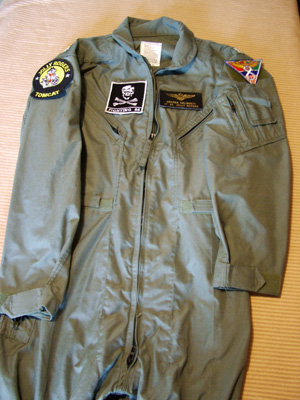
US Navy fire -resistant CWU-27/P Flight suit |
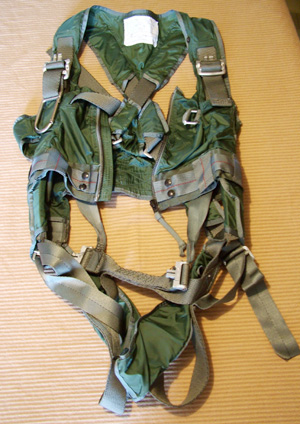
US Navy torso harness MA-2. |

US Navy survival vest SV-2 |
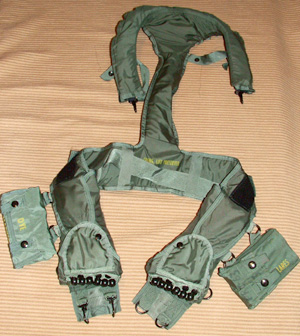
US Navy life preserver LPU-23/P. Used in aircraft equipped with ejection seat. |
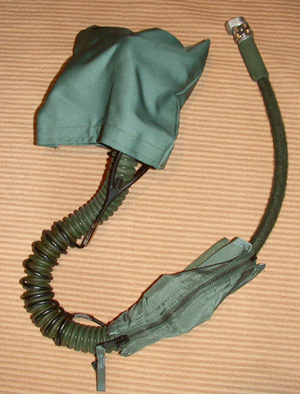
US Navy mask and oxygen regulator bags |
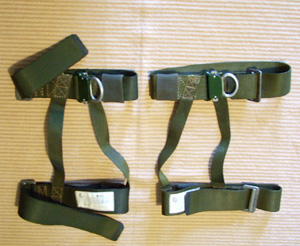
US Navy leg restraint garters used on GRU-7A ejection seat |
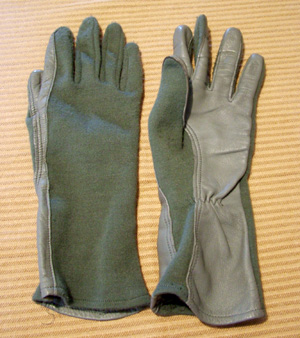
Fire-resistant flight gloves GS/FRB-2 |
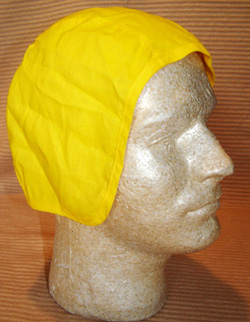
Skull cap |
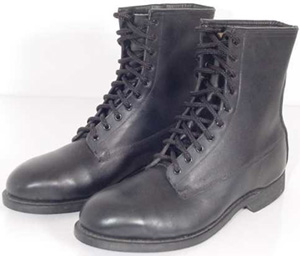
flight boots. (flighthelmet.com) |
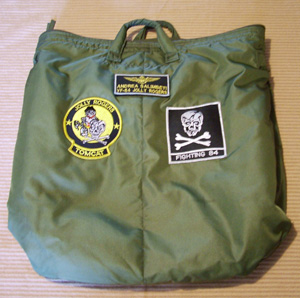
US Navy flight bag |

US Navy Nomex flight jacket CWU-45/P |
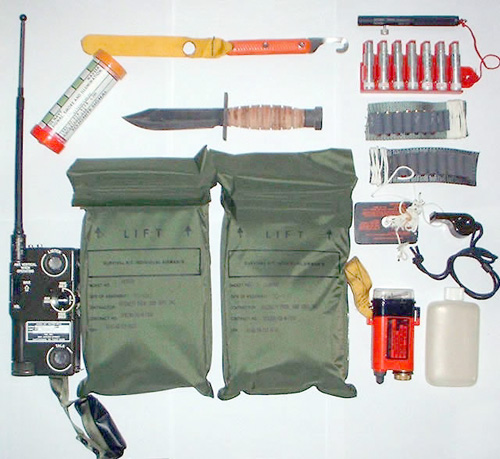
US Navy SV-2 survival vest components. |
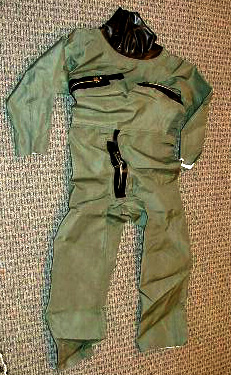
US Navy anti exposure flight suit CWU-62 |
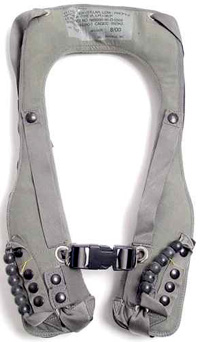
low profile flotation collar LPU-36/P. Used in aircraft equipped with ejection seat. |
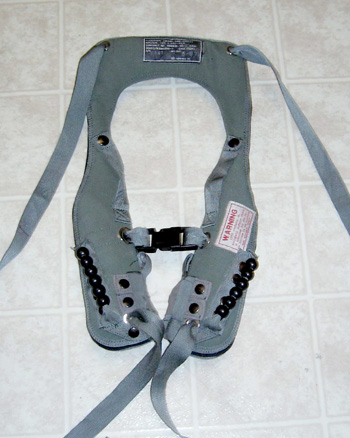
low profile flotation collar LPU-36/P. Used in aircraft equipped with ejection seat. |
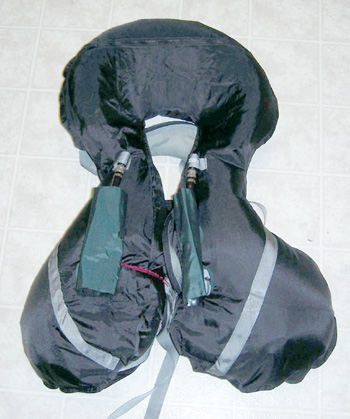
Inflatted LPU-36/P |

US Navy MBU-16/P oxygen mask with CRU-88/P pressure regulator. |
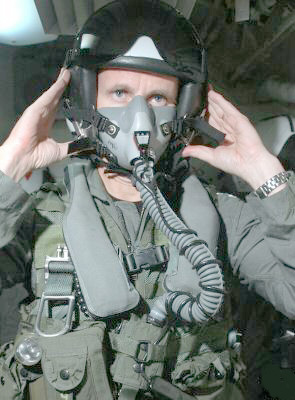
US Navy F/A-18 pilot in late 90s with PCU-33/P torso harness, CMU-33 survival vest, LPU-36/P life preserver, MBU-14/P oxygen mask and HGU-68/P flight helmet. (US Navy) |
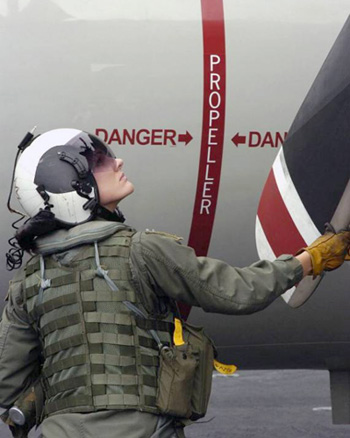
US Navy Hawkeye pilot with CMU-33 survival vest, LPU-34/P live preserver and HGU-74/P helmet. (US NAVY) |
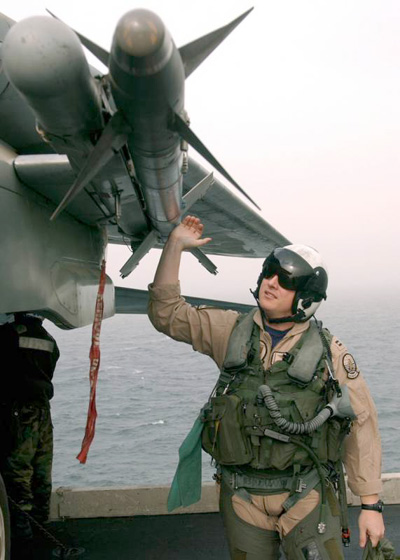
US Navy F-14 pilot with during late 90s with PCU-33/P torso harness, CMU-33 survival vest, LPU-36/P life preserver, MBU-14/P oxygen mask and HGU-68/P flight helmet. (US Navy) |
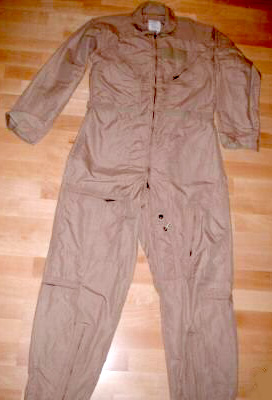
Tan color flight suit CWU-27/P. |
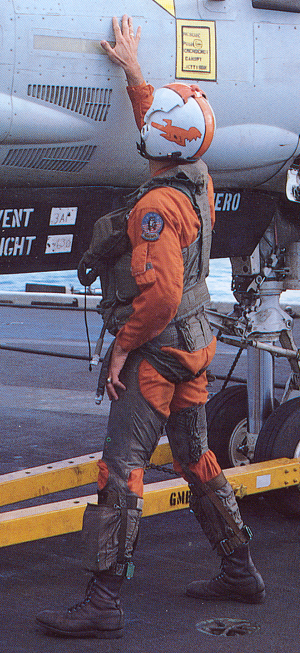
US Navy NFO from VF-114 Aardvarks during the middle of 80s. |
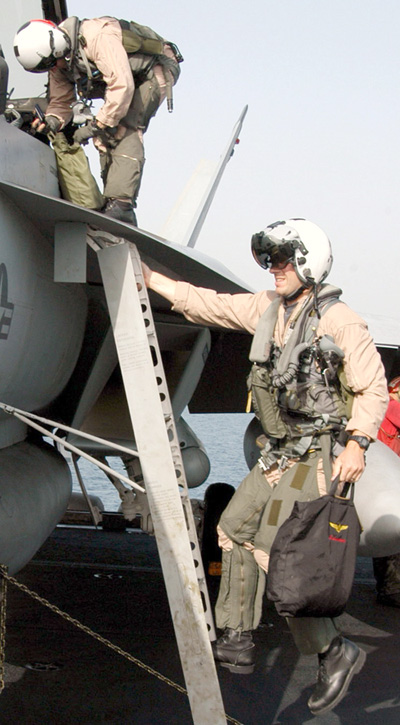
US Navy F/A-18F pilot of VFA-41 with JHMCS helmet during early 2000. (US Navy) |
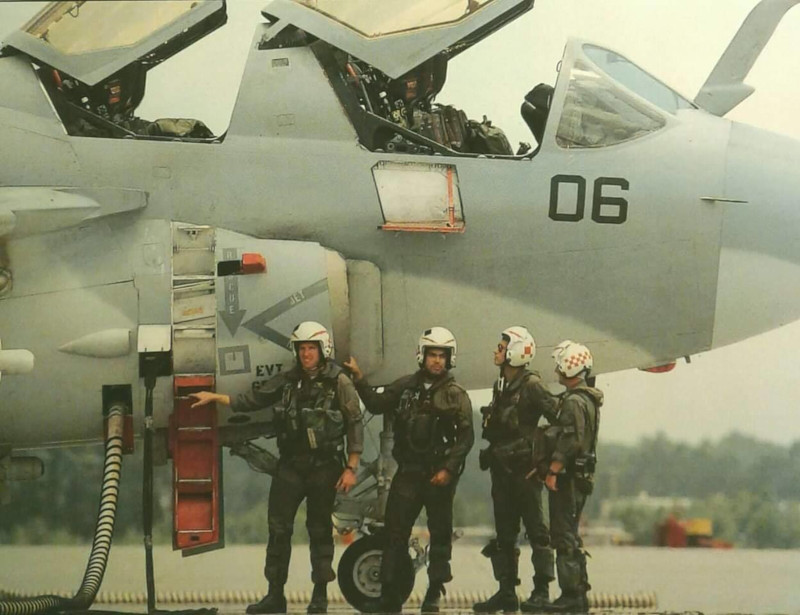
US Navy Prowler Pilot and NFOs during the 80s (US Navy) |
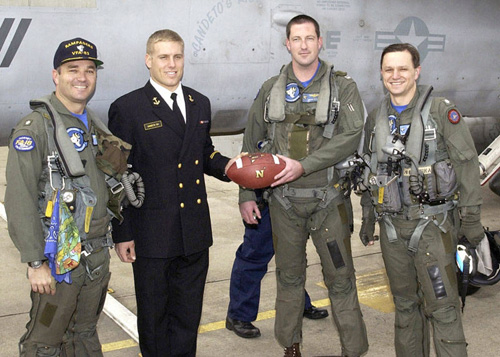
US Navy F/A-18 pilots during late 90s. (US Navy) |
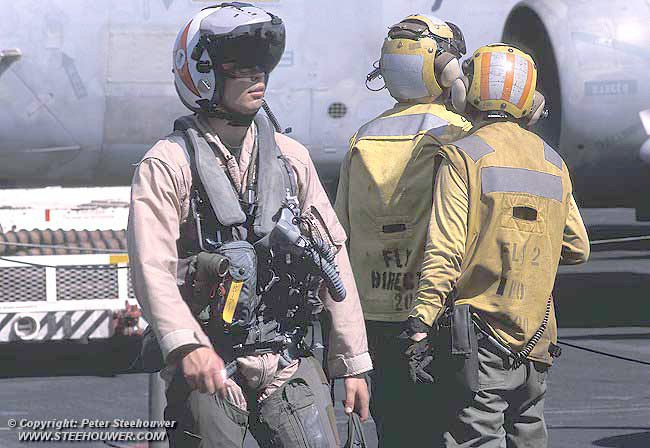
US Navy F/A-18E pilot of VFA-14 with JHMCS helmet during early 2000.(www.steehouwer.com) |
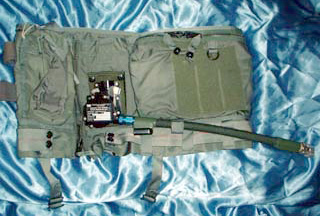
US Navy SV-2 vest with CRU-88/P oxygen pressure regulator. |
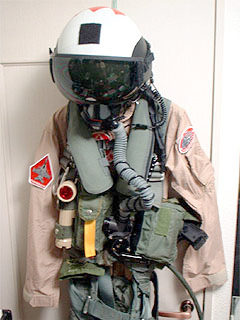
US Navy VFA-102 gear set. |
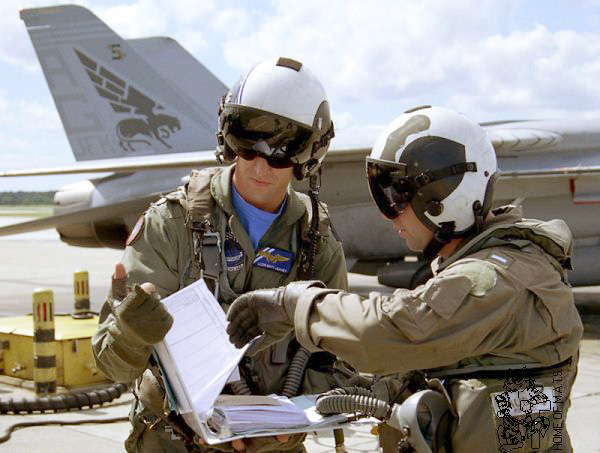
US Navy F-14 pilots of VF-143. (US Navy) |
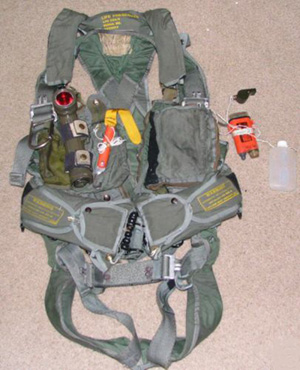
USMC modified MA-2 torso harness with LPU-23/P life preserver. |
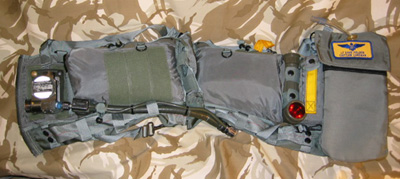
US Navy SV-2B vest with CRU-88/P oxygen pressure regulator. (Davey) |
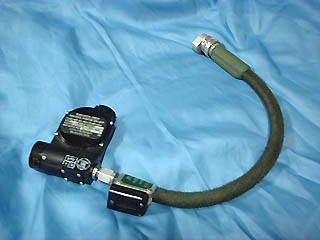
US Navy CRU-82/P oxygen pressure regulator. |
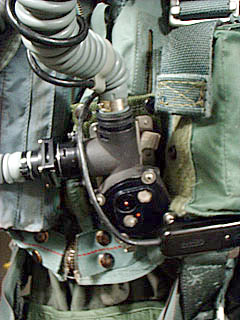
US Navy CRU-103/P oxygen pressure regulator. (Davey) |
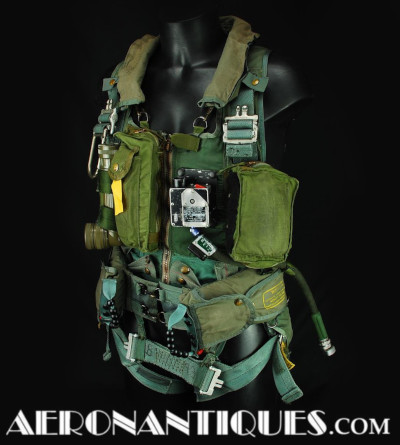
US Navy modified MA-2 torso harness used during the half of the 90s. (AERONANTIQUES.COM) |
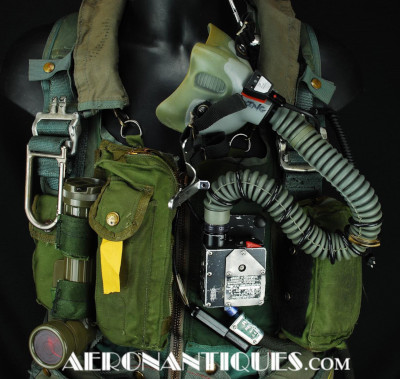
US Navy oxygen pressure regulator and MBU-15/P used during the half of the 90s on S-3 Viking . (AERONANTIQUES.COM) |
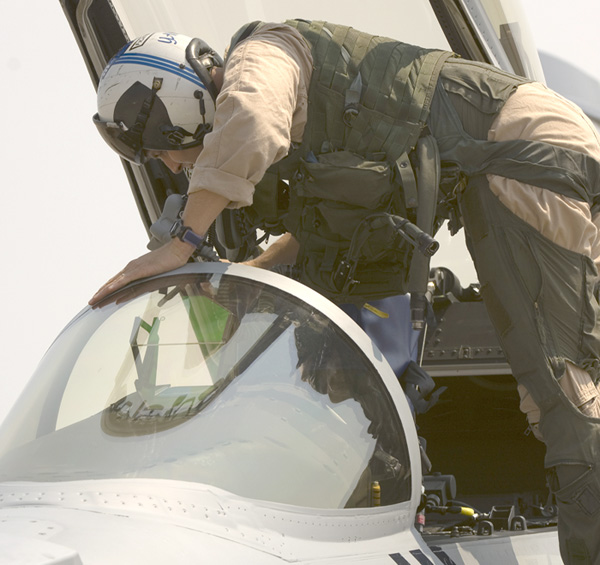
US Navy F/A-18 pilot of VFA-143 with CMU-33 vest and LPU-36/P life preserver. (US Navy) |
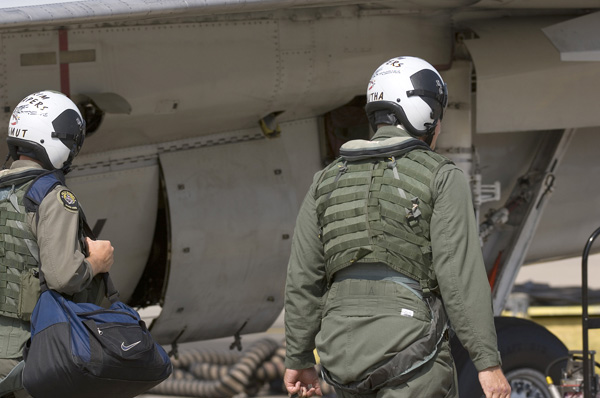
US Navy F-14 pilots of VF-101 with CMU-33 vest and LPU-36/P life preserver.(US Navy) |
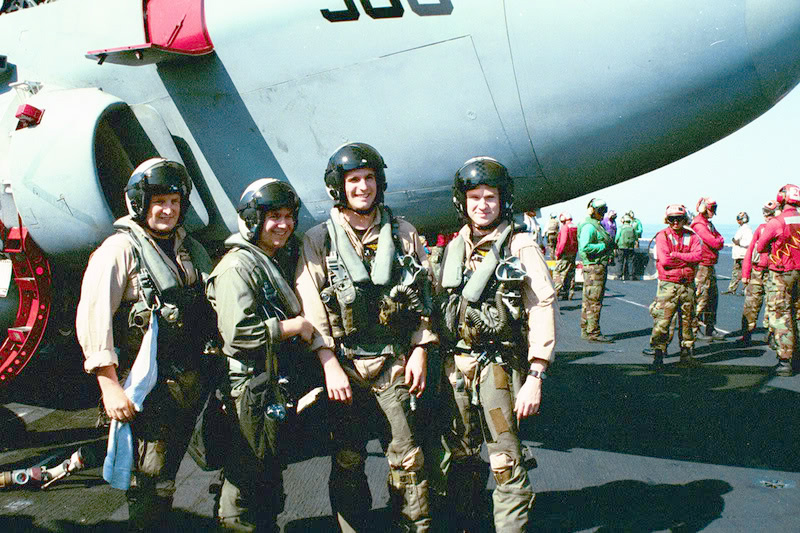
US Navy Prowler crew of VAQ-137 with modified MA-2 torso harness and LPU-36/P life preserver.(US Navy) |
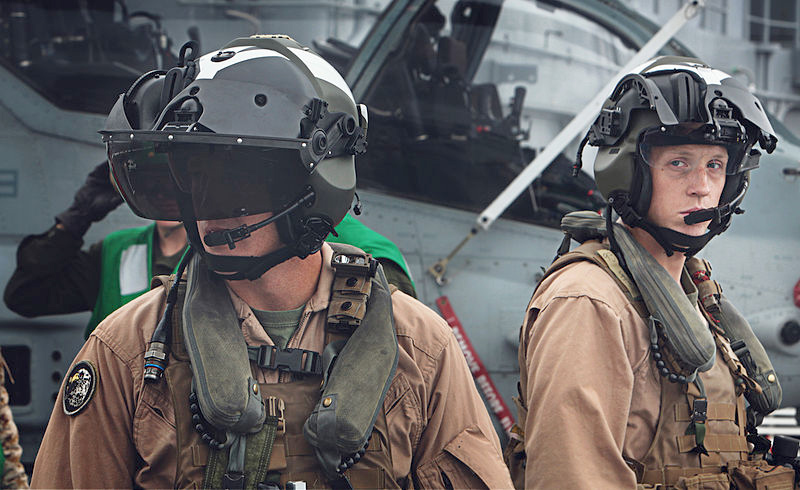
USMC AH-1Z Supercobra pilots equipped with the Thales "Top Owl" helmet-mounted sight display system. The "Top Owl" has a 24 hour day/noght capability and a binocular display with a 40° field of view. Its visor projection provides forward looking infrared (FLIR) or video imagery. However, the USMC has decided to augment it with existing night vision devices. (US Navy) |
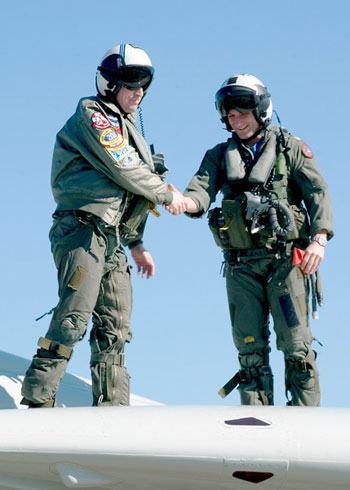
F-14 pilots of VF-143 (US Navy) |

F/A-18F pilot from VF-103 Jolly Rogers. (US Navy) |
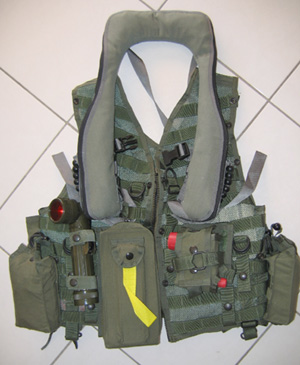
US Navy CMU-33 vest and LPU-36/P life preserver |
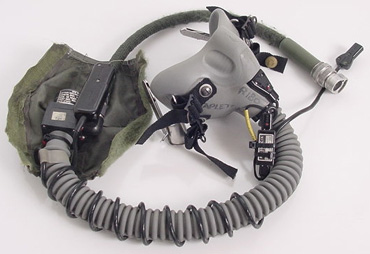
US Navy MBU-14/P with USAF MBU-12/P microphone and external amplifier. |
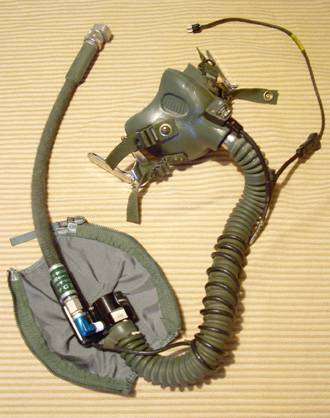
US Navy green MBU-14/P with pressure regulator CRU-79/P used during the early 80s |
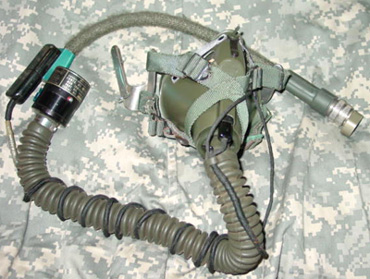
US Navy MBU-5/P pressure regulator CRU-79/P used during the early 80s. (Hans) |
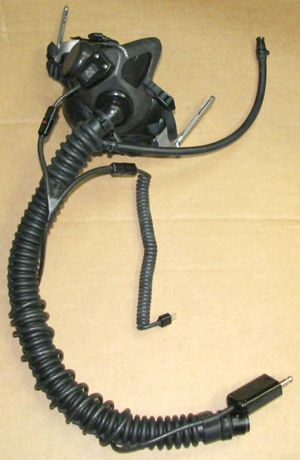
Unusual black MBU-20A/P with new US Navy microphone and combat edge hose. |
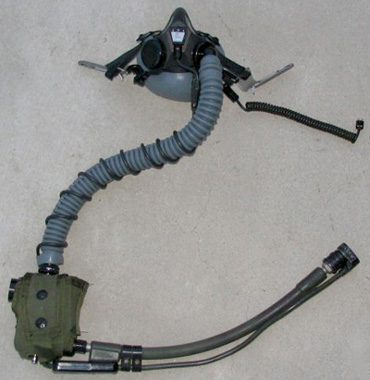
US Navy MBU-23/P oxygen mask with pressure regulator CRU-103/P. (Surplusagent) |
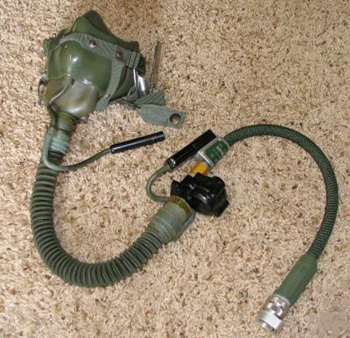
US Navy MS22001 oxygen mask with mini pressure regulator used during the early 80s.(Surplusagent) |
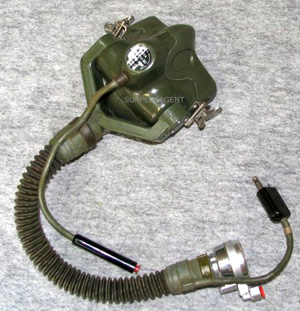
Very rare US Navy Model Sierra 756 oxygen mask with pressure regulator used during the late 70s early 80s. (Surplusagent) |
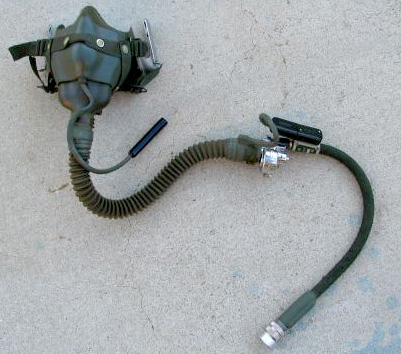
US Navy MS22001 oxygen mask with rare Firewell Co. mini pressure regulator used during the early 80s.(Surplusagent) | 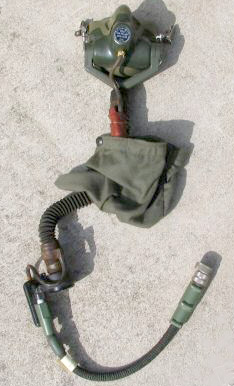
Very rare US Navy Model Sierra 756 oxygen mask with pressure regulator and REDAR hose used during the late 70s early 80s. (Surplusagent) |
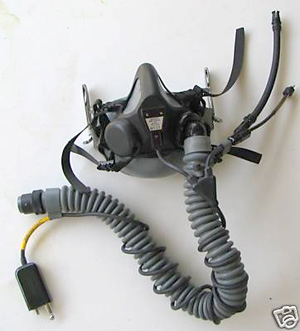
US Navy MBU-24/P used on Combat Edge Helmets ATLSS, HGU-87/P and HGU-89/P.(Surplusagent) | 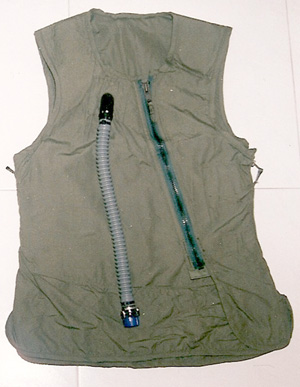
US Navy CSU-21/P anti g vest |

Female F/A-18F pilot with JHMCS flight helmet.(US Navy) | 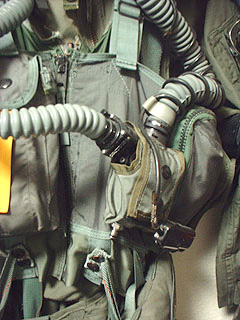
SV-2B vest pocket for CRU-103/P oxygen pressure regulator. |

US Navy anti g pants CSU-20/P.
| 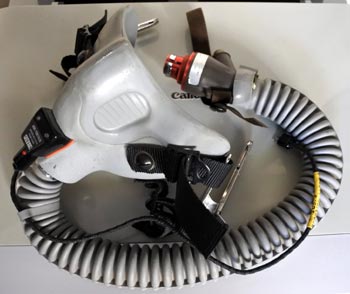
US Navy MBU-17/P Oxygen Mask as used om E-2C Hawkeye. |

During the 80s the Beretta M9 replaced the S&W 38 revolver (information by Justin Brooks)
| 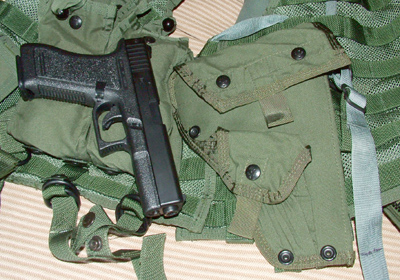
US Navy holster with MOLLE straps as used on CMU 33 survival Vest and Glock 17. Some aviators both USN and USAF have carried Glock 17's and 19's of their own because it is lighter, simpler, smaller and same capacity of the standard M9. Even the full size G17 is still a bit smaller than the M9. (Information by Justin Brooks)
|
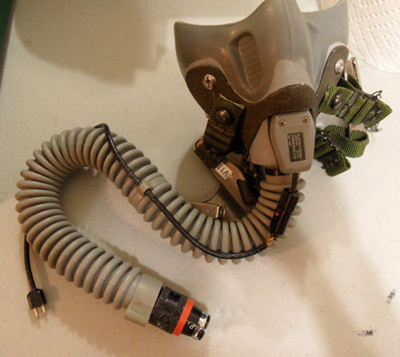
MBU-12/P with M32015/41 internal microphone and ridged bayonet face guard. This mask was probably used on V-22 Osprey.
| 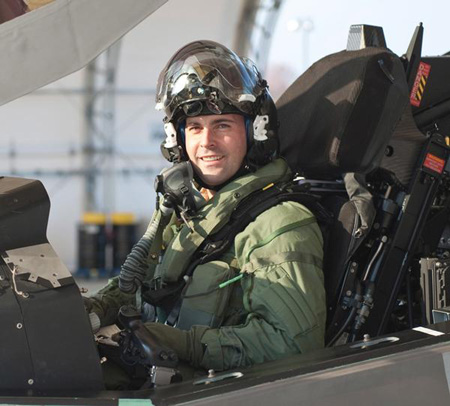
Marine Corps Maj. Richard Rusnok with the new flight equipment and HMDS flight helmet used on F-35B. |
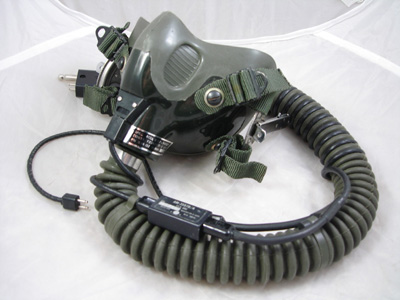
Early type of MBU-12/P used on US Navy aircraft with microphone amplificator.
| 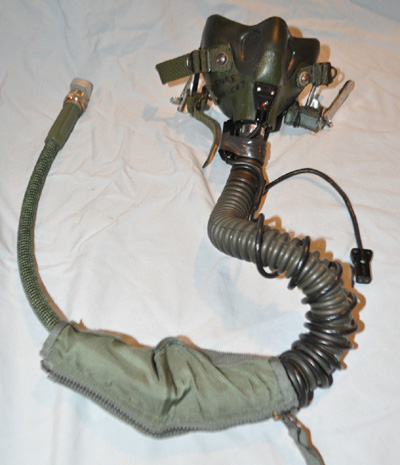
Another MBU-12/P used on US Navy aircraft with external microphone amplificator and REDAR hose |
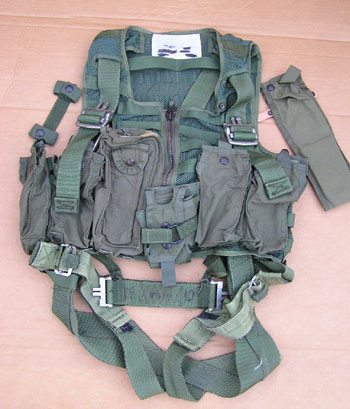
US Navy PCU-78 integrated flight vest and harness.
| 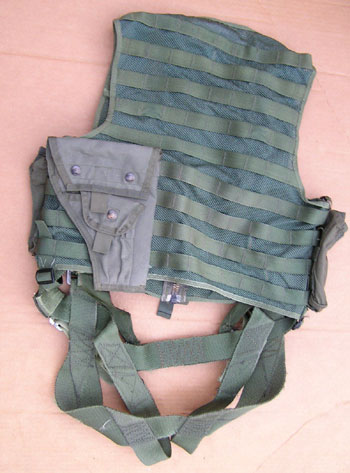
The PCU-78 is basically a PCU-56 with the molle material of the CMU-36 vest built right in. |
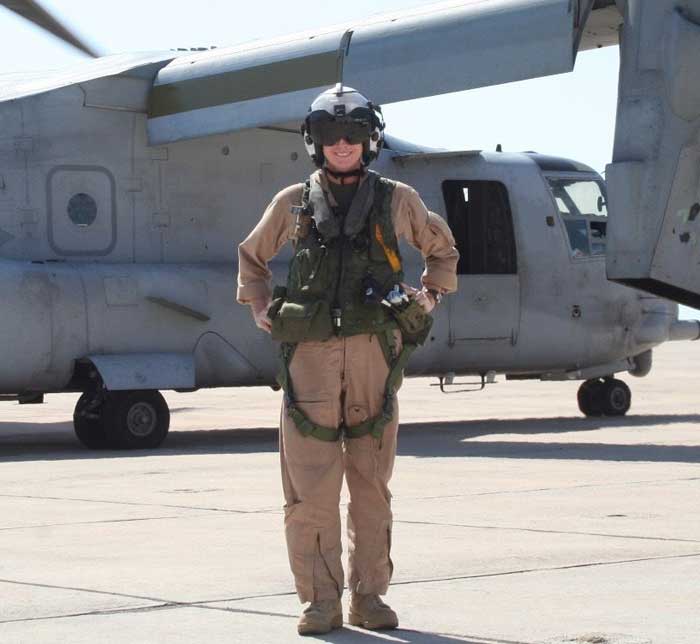
US Marines Osprey crew member with CMU-33 survival vest, LPU-34/P live preserver and HGU-67/P flight helmet normaly used on helicopters. (US Navy) |
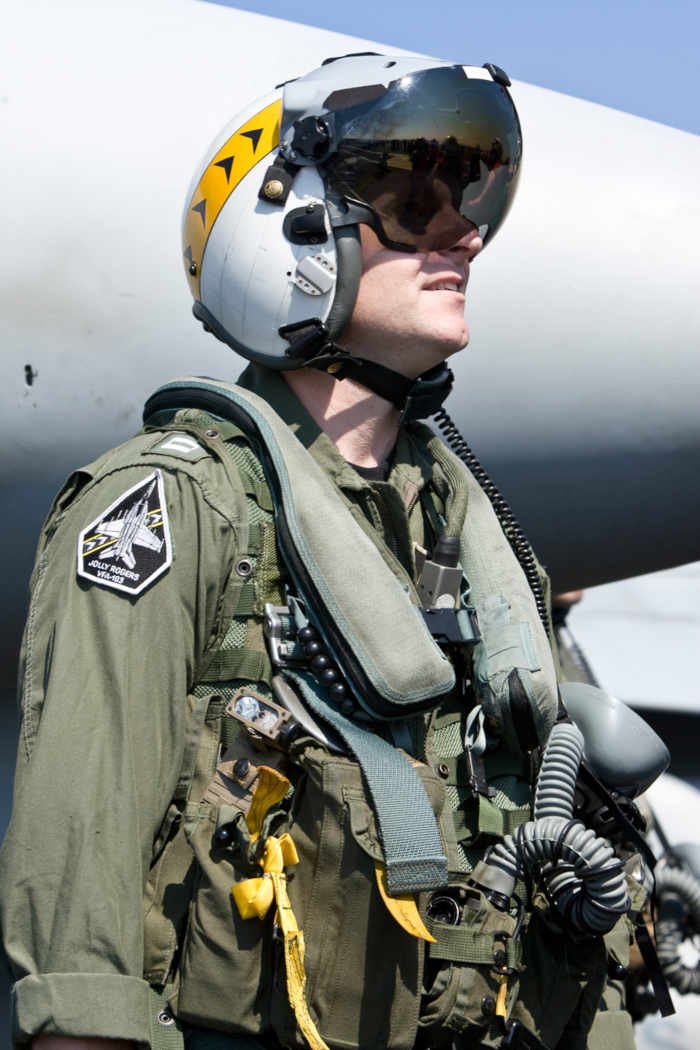
US Navy F/A-18F pilot from VF-103 during the early 2000. (US Navy) |
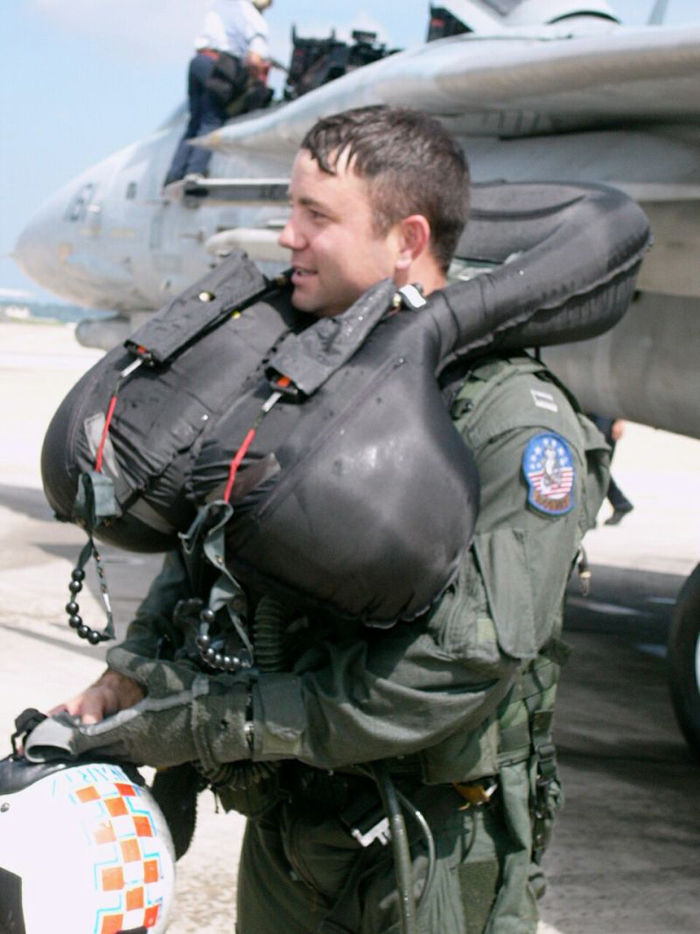
US Navy F-14 pilot with LPU-36/P Inflatted. (US Navy) |
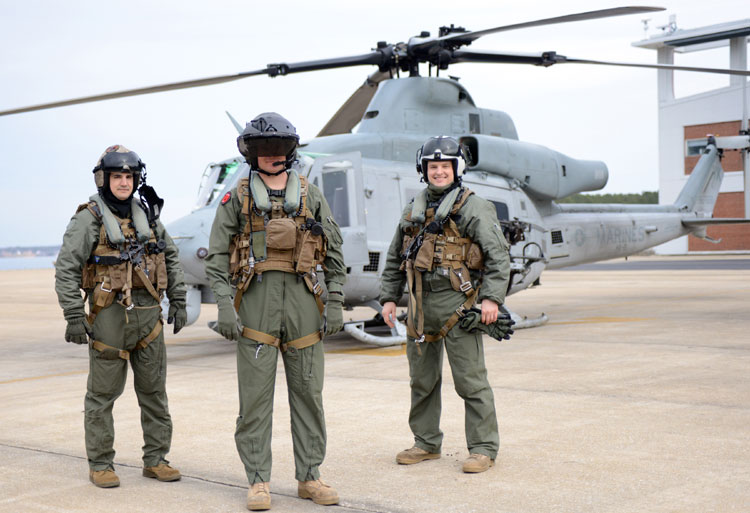
US Marines helicopter crew with the new Aircrew Endurance (AE) Survival Vest. This model is Lighter than its bulky predecessor.
The upgraded AE survival vest provides improved ballistic-protection, superior load distribution and a new universal color for deployment in a wider variety of terrains.(US Navy) |

Lt. Cmdr Joseph Furco of VFA-105 Gunslingers conducts a pre-flight inspection on a F/A-18E Super Hornet. (US Navy)
| 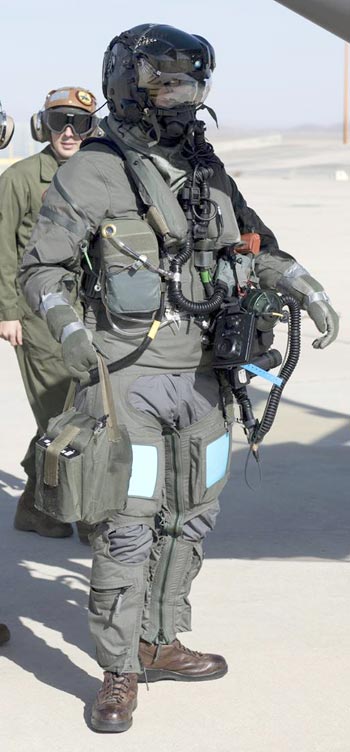
USMC Maj Aaron Frey with Chemical Biological ensemble used on F-35B. (USMC) |
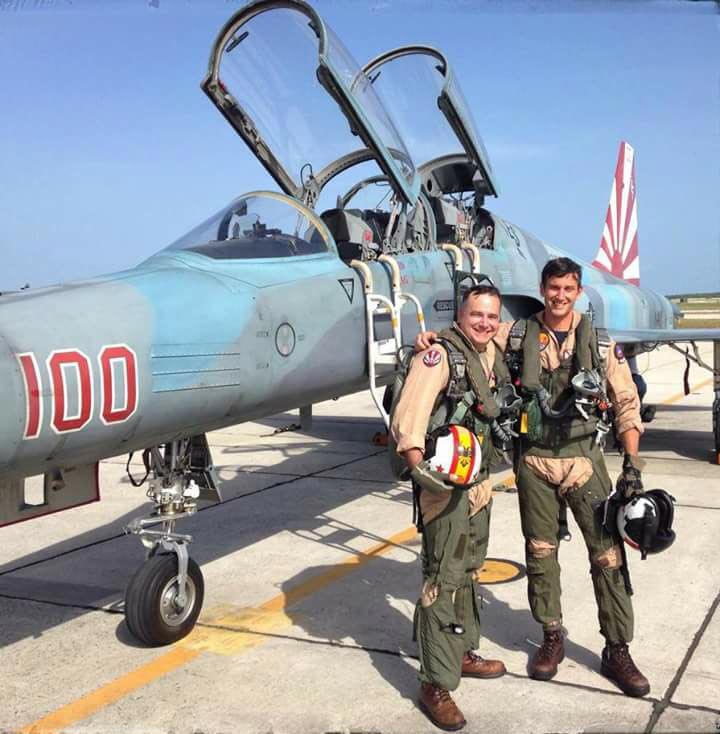
US Navy and Spanish Navy Pilots during an Air Combat Training with a F-5N from VFC-111 "Sundowners".(US Navy) |
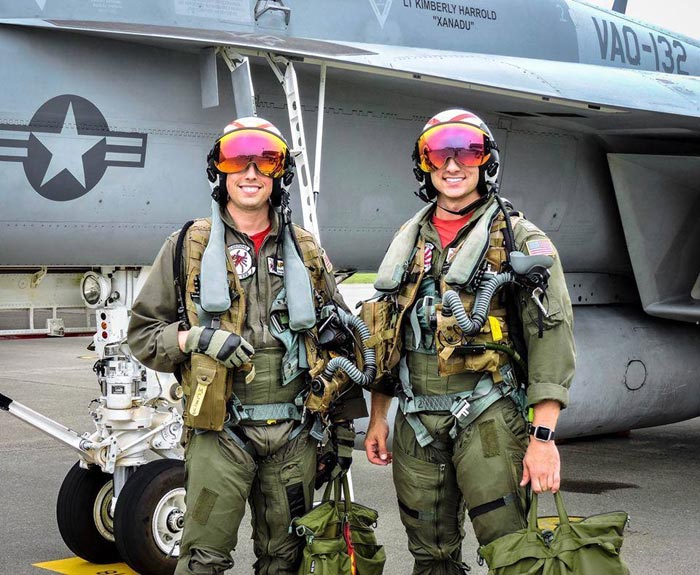
US Navy E/A-18G Growler pilots of the VAQ-132 during the 2018.(US Navy) |
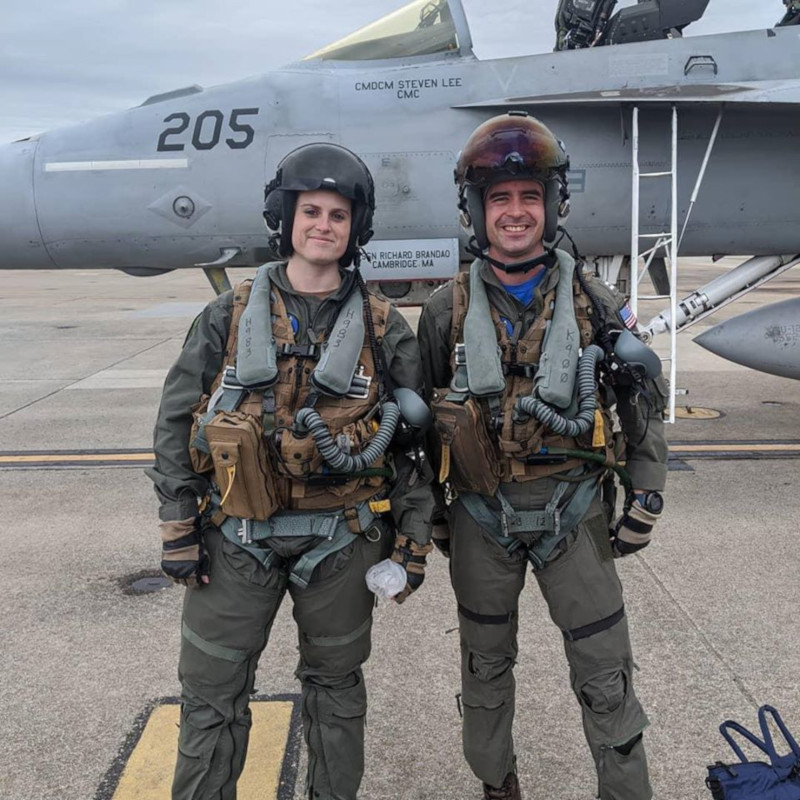
US Navy F/A-18F crew during the 2020.(US Navy) |
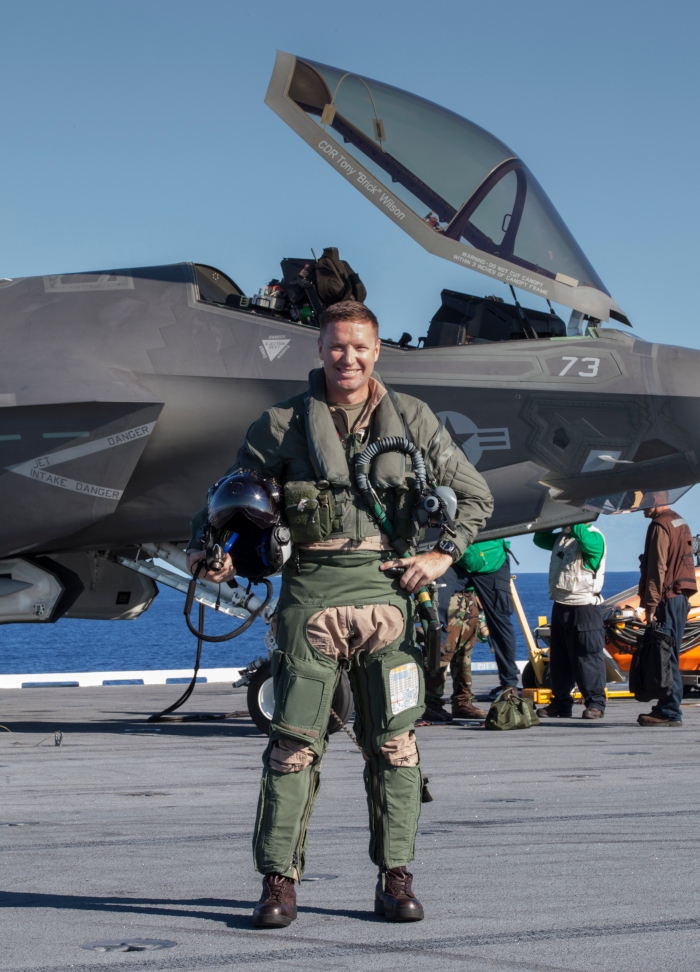
USMC F-35B pilot Maj Eric Northam during the 2018.(US Navy) |
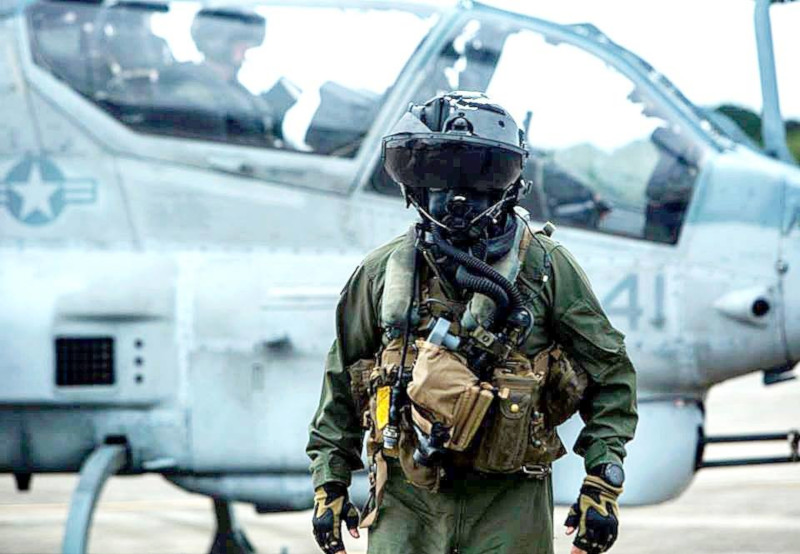
Capt. Justin P. Morrison steps away from his AH-1Z Viper to take off his Joint Protective Aircrew Ensemble (JPACE) and Respirator equipment during a training event on Marine Corps Air Station Futenma, Okinawa, Japan, Feb. 8, 2018. The training event was to familiarize pilots with the JPACE.(US Navy) |
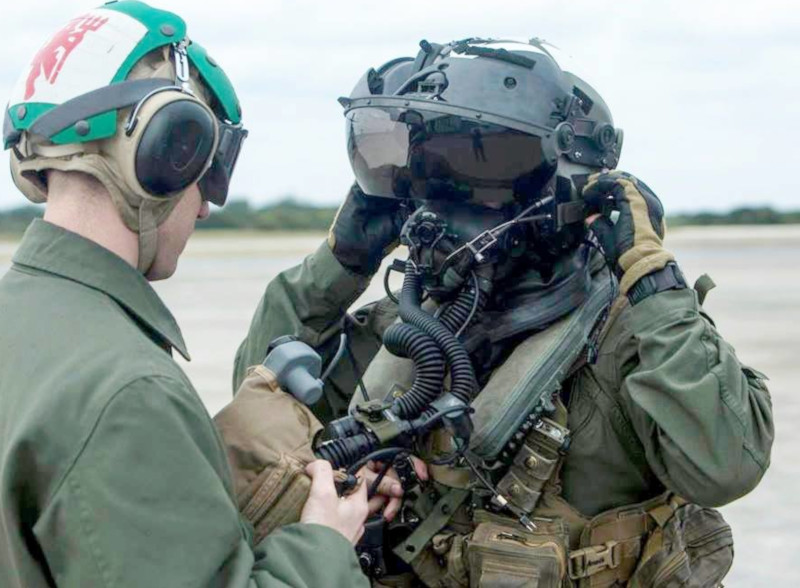
The JPACE will increase the protection provided over existing garments while reducing heat stress and system weight. The equipment will provide chemical protection against all liquid, particle, vapor and aerosol from chemical, biological, radiological and nuclear agents.(US Navy) |
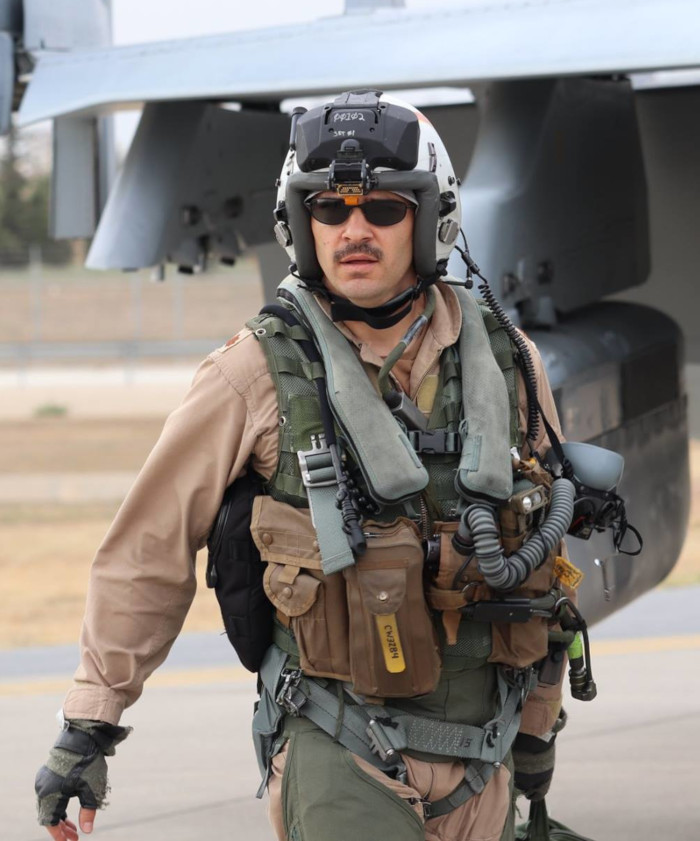
US Navy E/A-18G Growler pilot during the 2019.(US Navy) |
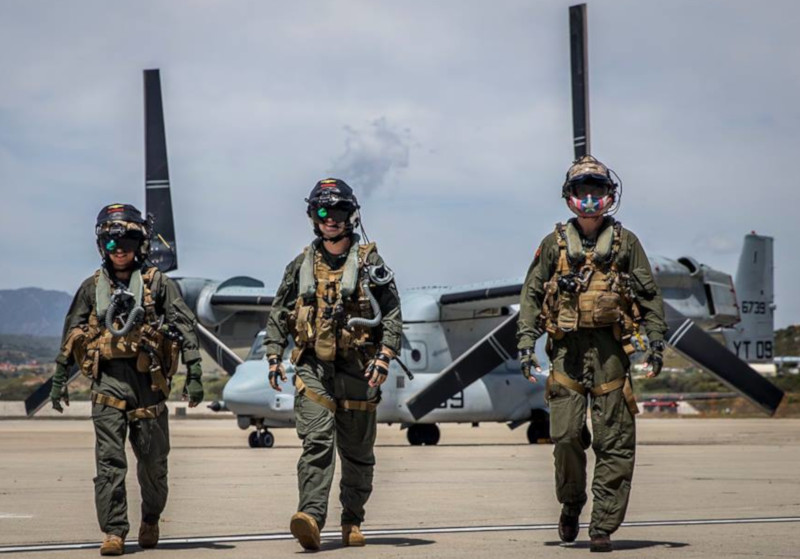
US Marines Osprey crew during the 2019.(US Navy) |
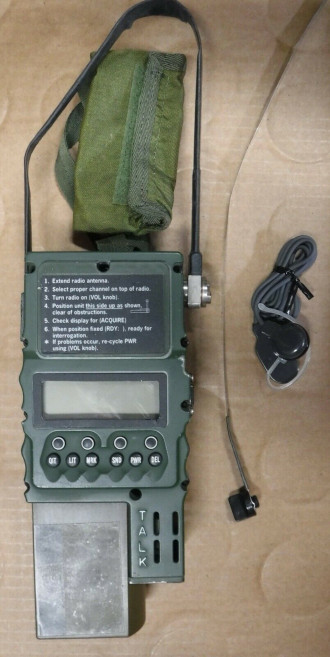
Survival Radio and GPS AN-PRC-112/B1 used on CMU-33 and CMU-36 survival vest. This radio replace the PRC-90
|
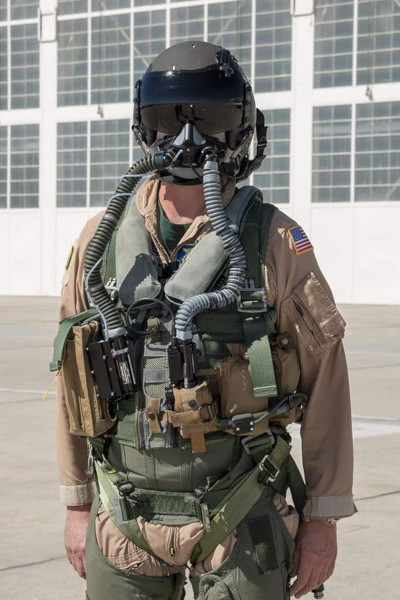
Smart Electronic Regulator will auto-adjust oxygen dose based on pilot physiological cues.
Cobham announces it has recently been awarded a contract by the Office of the Secretary of Defense to develop the Autonomous Pilot Life Support System (APLSS). The resulting system will be the world’s first sensor driven breathing regulator to automatically adjust oxygen dosed to the pilot based on changing physiological need and dynamic aircraft conditions. Cobham’s SmartFLO™ electronic breathing regulator will autocorrect flow to proactively pre-empt the onset of hypoxia-like symptoms if unexpected changes in cabin pressure or excessive expired carbon dioxide levels in the pilot’s breathing are detected to better protect the pilot. Delivery of the SmartFLO™ regulator is anticipated in 2020.
| 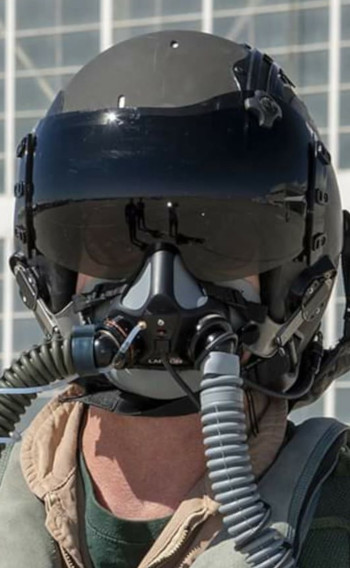
Cobham’s VigilOX™ breathing sensors are currently being flight tested to monitor and collect data on pilot respiration through expired oxygen and carbon dioxide levels to better understand human-aircraft interactions regarding unexplained physiological events. While data analysis is on-going, we are now moving forward in developing a ‘predict and protect’ capability that will use real-time sensor data to cause the SmartFLO™ regulator to auto-adjust flow based on cabin pressure and physiological cues. The result essentially customizes oxygen dose to enhance pilot safety and performance,” said Rob Schaeffer, Product Director, Environmental Systems at Cobham Mission Systems. |
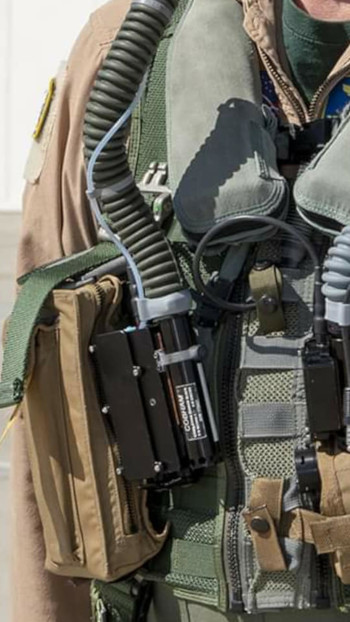
Through the APLSS program, Cobham will expand its VigilOX™ sensor system respiration data profile by integrating additional inputs from Elbit Systems’ Canary product, a real-time pilot health monitoring system that captures hemo-dynamic pilot data. This expanded data profile will paint a more complete picture of what is happening to the pilot physiologically during all flight conditions. Cobham will develop an algorithm to drive the regulator to increase or decrease oxygen dose flowing to the pilot based on sensor inputs.
“This autonomous self-regulating capability is a paradigm shift that extends beyond monitoring and requiring the pilot to take manual corrective action. The SmartFLO™ regulator will automatically respond to protect the pilot, which provides a layer of vigilance that has not existed before,” said Schaeffer.
| 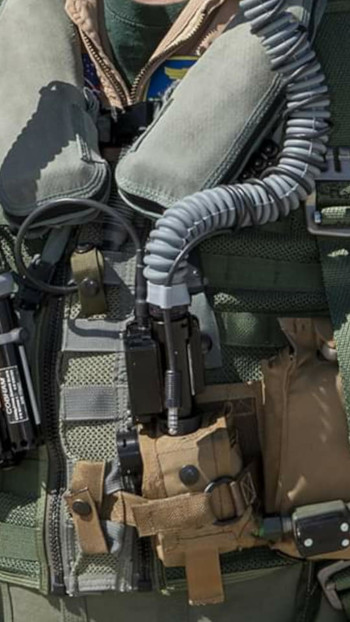
The SmartFLO™ self-adjusting regulator and the SureSTREAM™ enhanced capability oxygen concentrator are the core building blocks towards Cobham’s goal of developing its complete auto response guided oxygen system, ARGOS™. ARGOS™ will automatically protect the pilot from the onset of hypoxia like symptoms by rapidly adjusting breathing gas dose based on dynamic pilot physiological demand and cockpit conditions. Cobham is also developing a SmartBOS™ back-up oxygen system that will automatically supply emergency oxygen as needed. Working with our VigilOX™ sensors, ARGOS™ will have the ability to control the entire pilot oxygen system from air source to mask. |
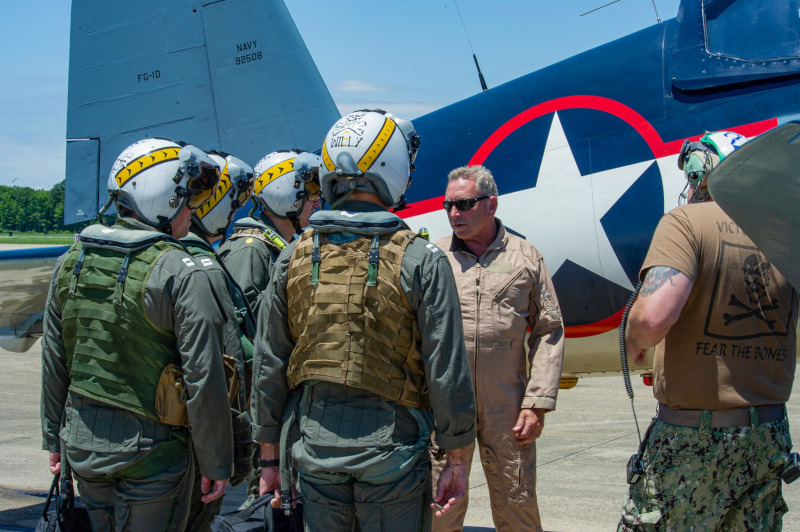
US Navy F/A-18F Super Hornet pilots form VFA-103 Jolly Rogers during the 2021.(US Navy) |
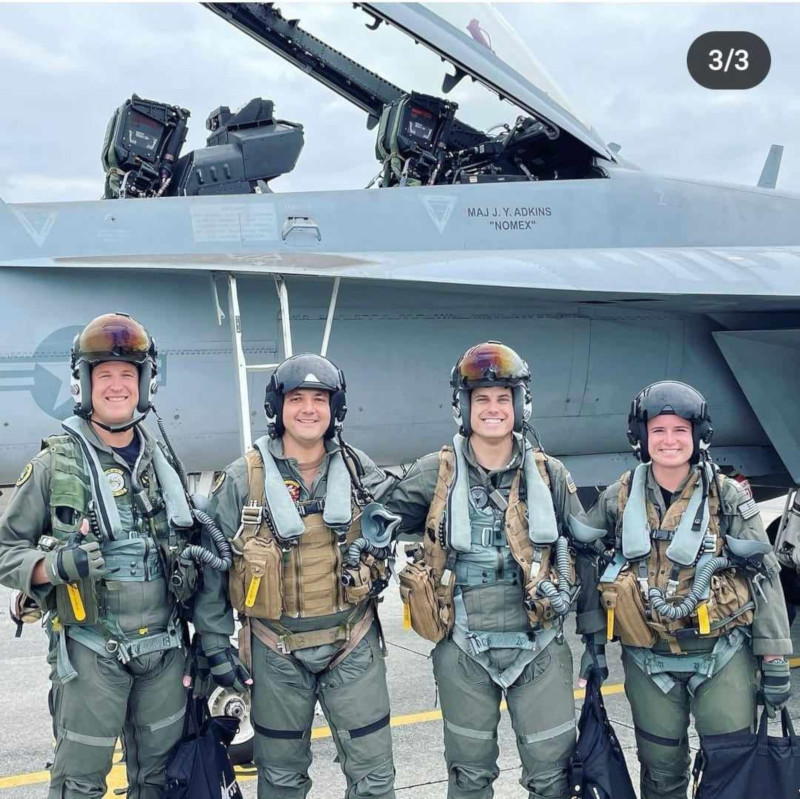
US Navy F/A-18F Super Hornet pilots with different variation of vest and harness.(US Navy) |